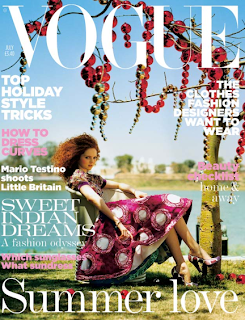Researching the content.
Vogue is a highly successful fashion publication that has been around for many decades. Throughout its time on the shelves it has created its own recognizable brand that has become iconic to the publication. It is this significant image they have created that has to be kept up and maintained to a high standard to ensure the continued success of the brand. Some might argue that it is the cover that ensures this success, as it is what draws its audience to the magazine rather than the many others on the newsstands. Each vogue cover has to represent the brand and has many factors that have to be considered to achieve this. From the photographer, the model, hair, makeup, location, cover stories and the colour of the ‘VOGUE’ written across the top of the magazine, each of these components that makes up the front cover has been strategically planned and thought out and it is the overall outcome that ensures the magazine maintains its high standard and world wide audience. Below you can see a few of my favorite past vogue covers.
The visual hierarchy of the magazine is also very apparent. It’s clear that the magazines title is the first point of reference for the viewer with the font, colour and typeface all drawing the viewer’s attention to the magazine. It is then the cover image and cover stories job to sell the magazine to the audience meaning that both have to be visually striking and consistent with the ‘Vogue image’. Everything that has been placed on the cover would have been strategically planned and mapped out by a team of people to ensure the best possible response and success from that issue. The covers I have displayed above may not be the most successful issues to date by I find them visually pleasing and they appeal to me in different ways than they might do to others. The fact that different people react to images and text in different ways is also something that has to be considered in publishing the magazine and it’s important that they find an equal balance to appeal to a wide genre of people. Vogue is a magazine that has been running for almost twelve decades with its first issue published in 1892 and has managed to stay successful throughout that time so they must be doing something right but in the long run it’s the audience that decides the success of the magazine as its them who chose to pick up one magazine from the next whether it be the text, colour or cover image that helps them do it.

















































